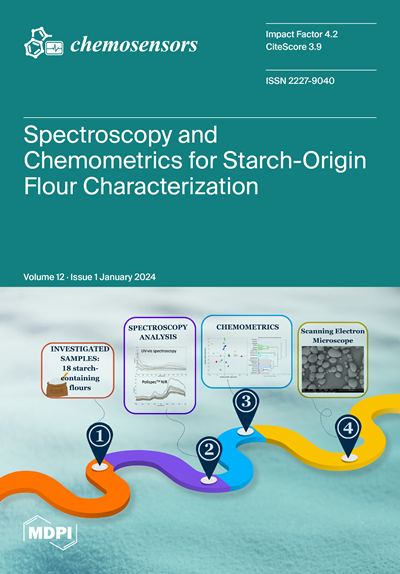等离子体纳米粒子作为SERS底物定量测定甲状腺素
IF 3.7
3区 工程技术
Q2 CHEMISTRY, ANALYTICAL
引用次数: 0
摘要
用抗坏血酸和单宁酸功能化金纳米粒子(NPs)作为SERS底物(SS)。在硅片上沉积不同负载的金属NPs制备了几种SS。我们聚焦于1044 cm−1处的甲状腺素(T4)条带,并追踪其在浓度为10 pM至1 mM时的强度和位置。对于所有SS,条带强度随着T4浓度的降低而降低。此外,随着NP负荷的增加,频带向更大的波数偏移。对于Au, NPs负载最高的SS,检测到的最小浓度为1 μM。相同负载的Ag NP SS在检测浓度为10 pM时表现出更好的性能,SERS-EF为109。纳米粒子的空间分布主要包括孤立纳米粒子、准球形纳米粒子簇和随机方向的纳米粒子半线性阵列。数值模拟结果表明,在由3个纳米粒子组成的线性阵列中,粒子间隙处的热点最为强烈。Ag NP SS表现出良好的灵敏度,可以检测pM浓度。因此,它对任何免疫测定技术的补充提供了一个有趣的替代点护理实现,如试纸。本文章由计算机程序翻译,如有差异,请以英文原文为准。
Thyroxine Quantification by Using Plasmonic Nanoparticles as SERS Substrates
Functionalized Au and Ag nanoparticles (NPs) with ascorbic and tannic acid, respectively, were used as SERS substrates (SS). Several SS were fabricated with different loads of metal NPs deposited on silicon wafers. We focused on the thyroxine (T4) band at 1044 cm−1 and tracked its intensity and position at concentrations from 10 pM to 1 mM. For all SS, the band intensity decreased as the T4 concentration decreased. Additionally, the band shifted to larger wavenumbers as the NP loads increased. In the case of Au, the SS with the highest load of NPs, the minimum concentration detected was 1 μM. The same load of the Ag NP SS showed a better performance detecting a concentration of 10 pM, an outcome from a SERS-EF of 109. The NP spatial distribution includes mainly isolated NPs, quasi-spherical clusters, and semi-linear arrays of NPs in random orientations. From the numerical simulations, we conclude that the hot spots at the interparticle gaps in a linear array of three NPs are the most intense. The Ag NP SS demonstrated good sensitivity, to allow the detection of pM concentrations. Therefore, its complementation to any immunoassay technique provides an interesting alternative for point-of-care implementations, such as test strips.
求助全文
通过发布文献求助,成功后即可免费获取论文全文。
去求助
来源期刊

Chemosensors
Chemistry-Analytical Chemistry
CiteScore
5.00
自引率
9.50%
发文量
450
审稿时长
11 weeks
期刊介绍:
Chemosensors (ISSN 2227-9040; CODEN: CHEMO9) is an international, scientific, open access journal on the science and technology of chemical sensors published quarterly online by MDPI.The journal is indexed in Scopus, SCIE (Web of Science), CAPlus / SciFinder, Inspec, Engineering Village and other databases.
 求助内容:
求助内容: 应助结果提醒方式:
应助结果提醒方式:


